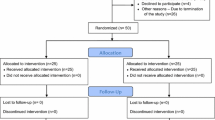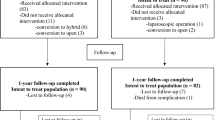Abstract
Purpose
No consensus has yet been reached regarding the optimal mesh for the repair of small ventral hernias. A composite polytetrafluoroethylene/polypropylene mesh (Ventralex®) is designed for this purpose, and this paper reports its use in a larger series of patients.
Methods
Open repair for a small ventral hernia was undertaken in 152 patients between April 2006 and June 2008. Data from medical files were gathered, and follow-up questionnaires were retrieved. Patients were asked about pain, intake of analgesics and various physical capabilities. Patients with postoperative complaints were offered a follow-up visit. Ultrasonography was performed if recurrence was suspected.
Results
Median surgery time was 39 min (range 16–129 min). Junior surgeons performed 63% of the operations. Questionnaires were returned by 81.6% with a mean follow-up of 15.6 months. Eighteen patients (11.8%) had complications. Pain score was significantly lower and the physical capabilities of the patients were significantly enhanced after the operation. Recurrent hernia was reported in four patients (2.6%). Five patients (3.3%) had the mesh removed due to deep infection, chronic pain or early recurrence. The training level of the surgeon had no influence on the incidence of complications. A 93.8% majority of the patients would recommend this specific procedure to others.
Conclusions
The intraperitoneal placement of this composite mesh is associated with a high level of patient satisfaction as well as low rates of both recurrence and infection.




Similar content being viewed by others
References
Burger JW, Luijendijk RW, Hop WC, Halm JA, Verdaasdonk EG, Jeekel J (2004) Long-term follow-up of a randomized controlled trial of suture versus mesh repair of incisional hernia. Ann Surg 240:578–583. doi:10.1097/01.sla.0000141193.08524.e7
Courtney CA, Lee AC, Wilson C, O’Dwyer PJ (2003) Ventral hernia repair: a study of current practice. Hernia 7:44–46. doi:10.1007/s10029-002-0102-0
Cassar K, Munro A (2002) Surgical treatment of incisional hernia. Br J Surg 89:534–545. doi:10.1046/j.1365-2168.2002.02083.x
Halm JA, Burger JW, Jeekel J (2004) Incisional abdominal hernia: the open mesh repair. Langenbecks Arch Surg 389:313. doi:10.1007/s00423-004-0487-6
Arroyo A, Garcia P, Perez F, Andreu J, Candela F, Calpena R (2001) Randomized clinical trial comparing suture and mesh repair of umbilical hernia in adults. Br J Surg 88:1321–1323. doi:10.1046/j.0007-1323.2001.01893.x
Lau H, Patil NG (2003) Umbilical hernia in adults. Surg Endosc 17:2016–2020. doi:10.1007/s00464-003-9027-7
Hadi HI, Maw A, Sarmah S, Kumar P (2006) Intraperitoneal tension-free repair of small midline ventral abdominal wall hernias with a Ventralex hernia patch: initial experience in 51 patients. Hernia 10:409–413. doi:10.1007/s10029-006-0127-x
Martin DF, Williams RF, Mulrooney T, Voeller GR (2008) Ventralex mesh in umbilical/epigastric hernia repairs: clinical outcomes and complications. Hernia 12:379–383. doi:10.1007/s10029-008-0351-7
Sanchez-Pernaute A, Perez-Aguirre E, Garcia BA, Rodriguez L, Antona EM, Cabeza J et al (2008) Prophylactic closure of trocar orifices with an intraperitoneal mesh (Ventralex) in laparoscopic bariatric surgery. Obes Surg 18:1489–1491. doi:10.1007/s11695-008-9598-4
Luijendijk RW, Hop WC, van den Tol MP, de L, Braaksma MM, IJzermans JN et al (2000) A comparison of suture repair with mesh repair for incisional hernia. N Engl J Med 343:392–398
Sanjay P, Reid TD, Davies EL, Arumugam PJ, Woodward A (2005) Retrospective comparison of mesh and sutured repair for adult umbilical hernias. Hernia 9:248–251. doi:10.1007/s10029-005-0342-x
Berrevoet F, Van den Bossche B, de Baerdemaeker L, de Hemptinne B (2010) Laparoscopic evaluation shows deficiencies in memory ring deployment during small ventral hernia repair. World J Surg 34:1710–1715. doi:10.1007/s00268-010-0600-7
Finan KR, Vick CC, Kiefe CI, Neumayer L, Hawn MT (2005) Predictors of wound infection in ventral hernia repair. Am J Surg 190:676–681. doi:10.1016/j.amjsurg.2005.06.041
Moro ML, Carrieri MP, Tozzi AE, Lana S, Greco D (1996) Risk factors for surgical wound infections in clean surgery: a multicenter study. Italian PRINOS Study Group. Ann Ital Chir 67:13–19
Medina M, Sillero M, Martínez-Gallego G, Delgado-Rodríguez M (1997) Risk factors of surgical wound infection in patients undergoing herniorrhaphy. Eur J Surg 163(3):191–198
Burger JW, Halm JA, Wijsmuller AR, ten RS, Jeekel J (2006) Evaluation of new prosthetic meshes for ventral hernia repair. Surg Endosc 20:1320–1325. doi:10.1007/s00464-005-0706-4
Mussack T, Ladurner R, Vogel T, Lienemann A, Eder-Willwohl A, Hallfeldt KK (2006) Health-related quality-of-life changes after laparoscopic and open incisional hernia repair: a matched pair analysis. Surg Endosc 20:410–413. doi:10.1007/s00464-005-0440-y
Eriksen JR, Poornoroozy P, Jorgensen LN, Jacobsen B, Friis-Andersen HU, Rosenberg J (2009) Pain, quality of life and recovery after laparoscopic ventral hernia repair. Hernia 13:13–21. doi:10.1007/s10029-008-0414-9
Conflict of interest
None of the authors had any financial relationship with the manufacturer of the described mesh.
Author information
Authors and Affiliations
Corresponding author
Rights and permissions
About this article
Cite this article
Iversen, E., Lykke, A., Hensler, M. et al. Abdominal wall hernia repair with a composite ePTFE/polypropylene mesh: clinical outcome and quality of life in 152 patients. Hernia 14, 555–560 (2010). https://doi.org/10.1007/s10029-010-0729-1
Received:
Accepted:
Published:
Issue Date:
DOI: https://doi.org/10.1007/s10029-010-0729-1




